Side Menu:
Fourth Officer Joseph Boxhall
-Titanic's Chartroom
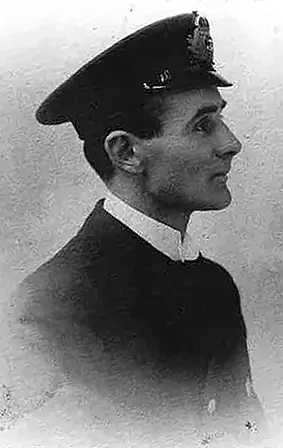
Undated image of a Joseph Boxhall
(Boxhall family/Inger Sheil)
During the British Inquiry, Boxhall was asked if the duty of a fourth officer was "in particular to plot on the chart things of that sort [ice]?" to which he replied: "No, I do not think so, but I just seemed to be the one that he [the Captain] told to do it each time." (British Inquiry)
Reports are firstly put on a noticeboard in the chartroom. Second officer Lightoller described it in his testimony at the British Inquiry: "We have a notice board in the chart room for the purpose of putting up anything referring to navigation, wireless reports on matters navigational, and it is open for anyone to look at." (British Inquiry). After which they were not taken down, as Boxhall confirmed at the British Inquiry: "The reports received for the ensuing voyage are kept there all the voyage." (British Inquiry)
It was also the particular duty of the junior officers to plot positions on the chart: "As soon as these messages are received, where there is ice, one of the junior officers of the watch plots the positions on the chart." (US Inquiry) At the British Inquiry he clarified that the Captain would sometimes leave a note for Boxhall to put positions on the chart: "On one or two occasions, as to anything to be plotted on the chart, he has just left it there with a note for me, or left it in the hands of some one else to give to me to put down on the chart. I have never seen fit to go and find the Captain and tell him I had done it. I took the first opportunity I had of seeing him to tell him I had carried out his instructions." (British Inquiry)
Hence it seems that Boxhall spent a lot of his time on duty in Titanic's chartroom. Even before they had set sail there were obstructions noted on their planned course which the Captain spoke to Boxhall about. "I do not know whether it was the day before or two days before. He gave me some positions of icebergs, which I put on the chart…On his chart... The captain gave me some wireless messages from Southampton, I think, that we had had before we had sailed, and asked me to put these positions on the chart." (US Inquiry)
Perhaps one of the reports Boxhall is referring to is the personal report to Captain Smith that was received on the 6th of April 1912, from Benjamin Steele, who was the marine superintendent for White Star Line at Southampton Docks, warning him of a potential obstruction ahead - the mast of a submerged wreck in the Atlantic.
Possibly referring to this wreck he also mentioned a "tank steamer drifting around" at the British Inquiry: "On one occasion I remember he [Captain Smith] gave something - I do not know whether it was a derelict - there was a message about a tank steamer drifting around on the track, that was it. And he mentioned it to one of the officers and told him to tell me to put its position on the chart." (British Inquiry)
April 12th: La Touraine
One of the earliest messages Boxhall recalls is from a French ship the La Touraine.
"There were icebergs reported from the captain of the Touraine, some time previously; it might have been a couple of days before. I put their position on the chart, and found that those positions were considerably north of the track. In fact, they were between the northern track and the southern track... With regard to the French steamer's positions, they were of no use to us, because he was considerably north of the track... I put them on the chart; but I remarked to the captain, "This fellow has been to the north of the track the whole way." So they were of no use to us; but they were on the chart, just the same. ..The Touraine, I think, was eastbound. " (US Inquiry)
Later he gave further details:
"I can not get the day, but it was probably a couple of days before, when we had a radiogram from the captain of La Touraine, giving his position at 7 o'clock Greenwich time, and I worked out our position at 7 o'clock Greenwich time and wrote out the time for Capt. Smith... and showed the captain the position the captain of La Touraine had given us….I recall this much, as I remarked to Capt. Smith, that those positions were of no use to us because they were absolutely north of our track. You will understand these French boats do not keep the recognized tracks we do. French boats are always to be found to the northward. Therefore I plotted all these positions out. He had given us the position of a derelict, or something, and when I plotted this derelict and these various icebergs he had seen I could almost form an opinion of this track he had taken, and I said, "They are out of our way…. It was put down just as carefully as I should have put it down if it had been on our course. I did not know exactly where she was until I saw the actual position on the chart. The captain saw me, and he was there alongside of me where I was putting the positions down, or shortly after I put them down, anyhow, he read the telegram and looked at it, and these positions satisfied him." (US Inquiry)
At the British Inquiry he also confirmed the La Touraine report:
"I do not remember the date exactly, but I think it was about a couple of days previous... I cannot give you the exact position, but, judging by the position he gave us shortly after he left New York, when he encountered a derelict, and then from the ice positions he gave us, when I put them down on the chart, I found out he had crossed the Banks, and it was too far north to be of any use to us. They were absolutely out of the way… miles north." (British Inquiry)
Also at the British Inquiry they referenced a possible issue with the position, as it was described in the telegram as "Paris" referring to Paris rather than British meridian. Boxhall said:
"We had some discussion on board the ship - the Captain, Mr. Wilde, and myself. I forget the difference in longitude between Paris and the British meridian, but we allowed for that... I believe it is something like 54 minutes, but I am not sure... if you look at your chart you will find that position is on the outward bound tracks ships follow between August and January which is right directly across the banks... All these positions were away to the northward and by dotting them down from the derelict which was the first to be reported, the westernmost report, and dotting all the positions he gave - he gave some icebergs beside field ice I believe - it showed he had taken the northerly track, and it was not worth considering, although I put it on the chart."(British Inquiry)
The exact content of the telegram Boxhall refers to is as follows:
April 12 1912
From Touraine To Capt. Titanic
My position 7pm GMT Lat 49.28 Long 26.28 w. dense fog since the night crossed thick icefield lat 44.58 long 50.40 paris saw another icefield and two icebergs lat 45.20 long 45.09 paris saw a derelict lat 40.56 long 68.58 paris please give me your position best regards and bon voyage. Caussin.
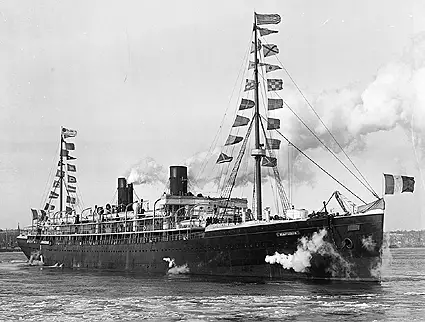
SS La Touraine, a French ocean liner.
According to the journal Le Gaulois on 20th April 1912, the "Touraine left New York for Le Havre on a scheduled voyage on Saturday 6th April….on 12th April, at 7:45 in the evening, she entered into conversation with the Titanic, which was about 100 miles east, on the way to New York. The giant vessel asked Touraine kindly to let her know at which latitude she had crossed the 50th meridian (from Greenwich) and if she had found any ice or fog there... Therefore, Touraine made it known to Captain Smith, of Titanic, that he had crossed the 50th at 44° 58" of latitude north and that she had had, at this point, serious entanglements with floating ice. By a last telegram, whose original I saw pinned up in the watch room of Touraine, Commander Smith thanked his French comrade, wished him bon voyage". The Captain Caussin was Commander Charles-Fernand Caussin who became captain of Touraine in September 1911 after leaving the French naval service. (Courtesy - http://flint-tools-in-touraine.blogspot.com/2016/12/la-touraines-titanic-adventure.html)
Second message: Amerika?
According to the British Inquiry there was indeed a second position after La Touraine. Boxhall said: "There were some positions we had and I fancy we got them leaving Queenstown or got them leaving Southampton… there was another one, but I cannot remember what it was after “La Touraine.” (British Inquiry)
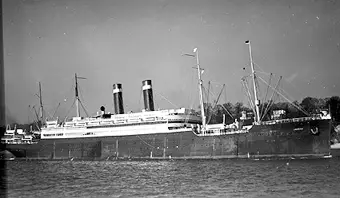
The SS Amerika
On another occasion during the British inquiry he replied that "there was another ice message which came shortly after the La Touraine. I pricked the two of them off at the same time, but I cannot think where it was from… only this, that the ice positions which it gave were to the north of the track; they were in all three cases. " (British Inquiry)
At the US Inquiry he mentioned the Amerika:
"Later, more positions came. I did not remember the name especially, but as soon as I saw the positions as shown at the time of the meeting of the committee, or when some member of the committee showed me those positions, with the name of the German boat, the Amerika, I recognized the positions. So they were evidently those of the Amerika that had been sent. I put those on the chart. I do not remember that any of them were on the track. To the best of my knowledge they were all to the northward of the track... I really did not calculate the distance. As soon as I saw they were on the north track I did not bother about measuring the distance... Of course, it was before we turned the corner. " (US Inquiry)
Although unusually, when later questioned specifically about the Amerika at the British Inquiry, he does not recall it, saying "I do not remember that message at all... I never heard anything about it." (British Inquiry)
Tank Steamer: Deutschland
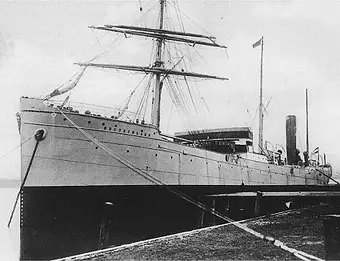
Tank Steamer, Deutschland.
Also two or three days prior to the collision Boxhall remembered a note on the message board about a tank steamer without coal drifting about: " I must add that there was a message which has come from somewhere or other about a tank steamer. I think we had two or three reports of a German tank steamer that was drifting about on the track without coal... this message on the notice board about the tank steamer had been there two or three days, " (British Inquiry)
This was also confirmed by a message on Sunday the 14th from the Baltic to Titanic at 1:42 p.m., "Last night we spoke with German oil tank steamer Deutschland, Stettin to Philadelphia, not under control, short of coal 40°42' N., 55°11' W. Wishes to be reported to New York and other ships."
However, Boxhall testified to not hearing about any messages from the Baltic at 1pm, as he was off duty on Sunday at this time:
15715. Now, have you any recollection of that message from the Baltic at one o’clock on the Sunday?
- No, I have not.
The Deutschland was picked up 14 April by Asian and towed to Halifax; arrived 18 April.
Concern for Passengers
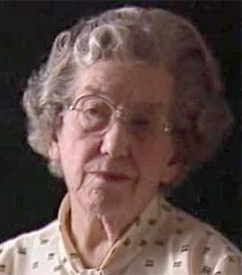
Eva Hart was 7 when she recalled an
officer - either Boxhall or Pitman,
concerned about her mother.
Seven year old Second-class passenger, Eva Hart, recalled an officer who had noted her mother's anxiety about being at sea, who she also met at the time of the making of the British film "A Night to Remember" (1958), meaning the officer was either Fourth Officer Boxhall or Third Officer Pitman:
One of the ship's officers was particularly pleased to see us all together at lunch and came over to speak to mother.
'Does this mean that now we are getting across the Atlantic you have got over your fears?' he asked. Have you finished sitting up guarding us at nighttime?' The remark was not intended unkindly, but no member of a ship's crew is anxious to have passengers who are worried about the safety of the ship, as this can upset other passengers on board.
'Oh no, I'm going to bed now' she replied.
The officer patted her on the shoulder and said light-heartedly, 'Ah, well, we shall be quite safe if you look after us again tonight.'
Many years later, that same officer reminded me of the conversation he had had at our lunch table, as he was one of the survivors who lived to see the making of the film A Night to Remember. (“A Girl Aboard the Titanic: A Survivor's Story”, Eva Hart, 2000)
Sunday: Caronia
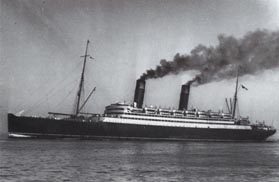
The RMS Caronia.
During the Senate Inquiry Boxhall at first states under oath that there were no ice reports during his Sunday watches. He said: "I have stated upstairs, or in Senator Smith's presence, this afternoon that I did not hear of any ice reports the day of the accident... I did not hear any. There were none reported to me. I do not think any were reported during my watch on deck, or I should have heard it… I was on deck on Sunday morning from 8 o'clock until noon, and I was on again from 4 until 6, and then I was on again from 8 until the time of the accident."
However, during the British Inquiry his memory was stirred by evidence and we have a first admission of ice being reported during his 4 - 6pm watch: "I cannot say from my own recollection that they were received on Sunday, but subsequently I have heard that some of them, or one of them that I put on the chart, was received on the Sunday, and that I put it on between 4 and 6. All the ice marked on the Captain’s chart I put down myself... it indicated the region of the ice... It conveyed to my mind that the ship would shortly be in the region of the ice. " (British Inquiry)
When asked to pinpoint the time he replied: "I do not remember myself, my Lord … subsequently I have heard it was on the Sunday, between 4 and 6, that I put some of the positions on." (British Inquiry) When asked if he marked the position on the chart he replied: "To my recollection, I did not, but others say that I did." (British Inquiry)
Later on he mentions the name of the ship, when prompted: " The “Caronia” Marconigram, I think, I must have marked, and probably that is the one that has been put down between 4 and 6, which they say was put down. I was on watch between 4 and 6 and it is quite likely I did it." (British Inquiry)
The Caronia's message was read to Boxhall at the British Inquiry: “Westbound steamers report bergs, growlers, and field ice in 42 N. from 49 to 51 W.” The Captain of the Caronia says that message was sent to the Titanic on the Sunday morning."" To which Boxhall replied: "Yes, I seem to recollect that message."
It seems Boxhalls memory was stirred by Second officer Lightoller and Third officer Pitman who both recall the Caronia message. According to his testimony at the US Inquiry, Third officer Pitman vaguely recalls Fourth officer Boxhall noting ice on the chart. He stated:
"I heard something about a wireless message from some ship... I was not on watch...; it was either Saturday night or Sunday morning... Mr. Boxhall put on the chart the position of the iceberg... He would just simply make a cross and write "ice" in front of it…As far as I can recollect, it was to the northward of the course; to the north of our track... I did not measure it, sir; and I have not the slightest idea of the position of it." (25.)
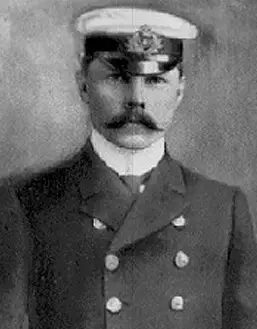
Pitman testified that Boxhall would
"make a cross and write 'ice' in front of it.""
Fifth officer Lowe also prompted Boxhall's recollection at the British Inquiry. Although he was not present when Lowe was giving evidence he was questioned about Lowe mentioning a "chit on the chart room table" to which Boxhall replied "I have not heard it till just now." But then he goes on to state: "The mentioning of it has refreshed my memory, and I remember writing it out… and it is the position of the “Caronia’s” ice. I copied it off the notice board to save taking the telegram itself down. I copied it on a chit and took it into the Captain’s chart room, and put it on the chart, and that is the ice that I must have put down between 4 and 6 in the evening." (British Inquiry)
However Boxhall did not place any importance on the Caronia message as "it was to the north of the track" which Boxhall calculated was "about" 10 miles north of their track. When asked at the British Inquiry whether ice would tend to move to move from north to south Boxhall initially agreed that it would "with the Labrador current" but then later clarified his position:
"No, it did not strike me that it would be moving southerly. I have never heard of ice so far south as that before, and I have invariably found that the Gulf Stream is much stronger there than the Labrador Stream is, as far south as that... I cannot say that I recollect ice being down as far south as 42 degrees." (British Inquiry)
During the US Inquiry he had made a similar point, noting that ice would likely drift north-east: "We should expect it to drift to the northward and to the eastward… Not to the southward, as a rule; not in the Gulf Stream." (US Inquiry)
Boxhall later admited that he was too busy and did not realise the importance of the message: "I cannot say that I had paid particular attention to the ship’s position that night; I had been too busy working it out, and I did not look it out on the chart; I did not realise the ship was so near the region of the ice. " (British Inquiry)
But by the end of the questioning he had to admit that the Caronia was an important message:
16974. Did any of the messages that you saw about ice convey to your mind that your ship would shortly be in the region of the ice?
- Yes.
16975. Which one?
- This “Caronia” message... I particularly remember now seeing the “Caronia’s” message on the notice board... Something about west-bound steamers reporting ice from latitude 42º to longitude 49º to 51º… - That is the “Caronia” message... I did not calculate it out; I had not the slightest idea when she would reach the region of the ice or of the “Caronia’s” position. (British Inquiry)
See also...
Next... Final Watches